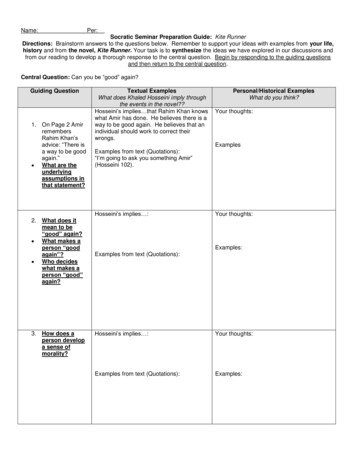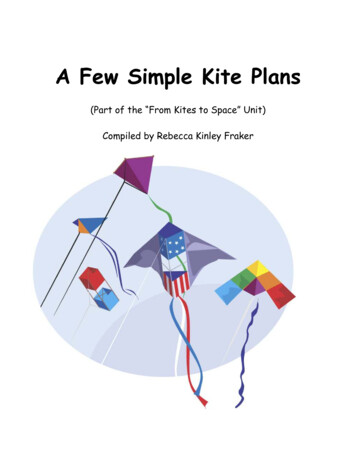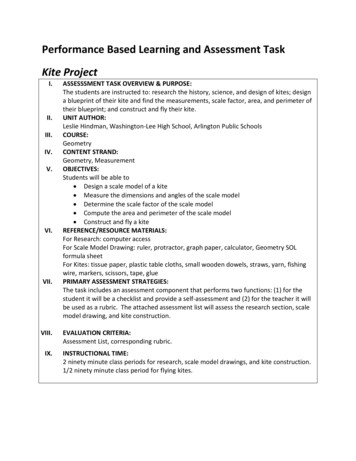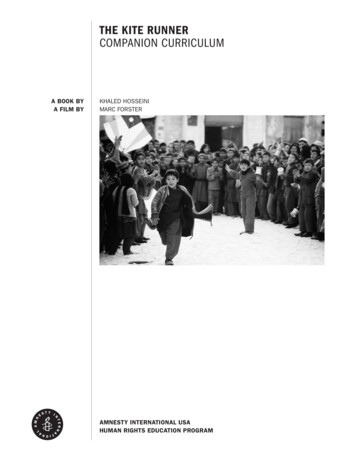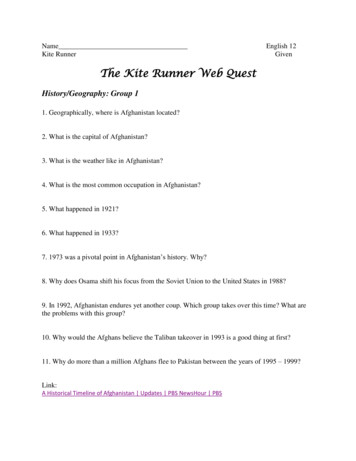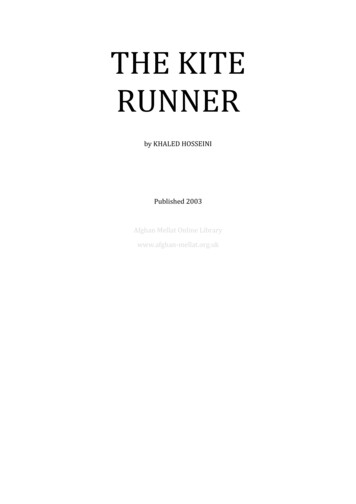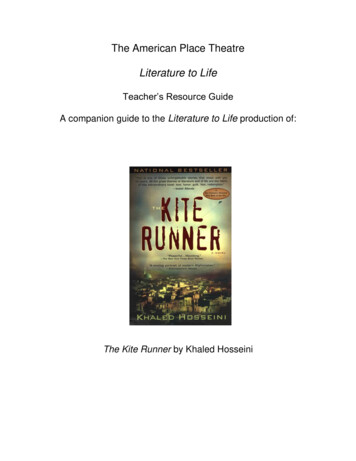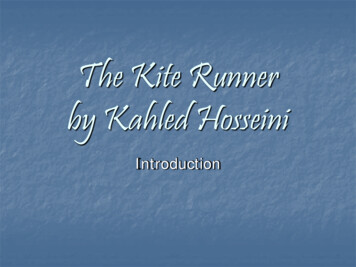
Transcription
The Kite Runnerby Kahled HosseiniIntroduction
About the Author Source: Khaled Hosseini Websitehttp://www.khaledhosseini.com/,accessed 17 February 2008.Khaled Hosseini was born in Kabul,Afghanistan in 1965.His mother was a teacher and hisfather a diplomat.His family left Afghanistan for aposting in Paris in 1976, wellbefore the Communist coup andthe Soviet invasion. Theyintended to return, but soughtpolitical asylum in the US in 1980.He now lives in California, wherehe works as a doctor.(Sherman 2006, p.5)
About The Kite Runner Hosseini states: ‘The story line of my novel is largelyfictional. The characters were invented and the plotimagined. However, there certainly are, as is always thecase with fiction, autobiographical elements woventhrough the narrative. Probably the passages mostresembling my own life are the ones in the US, with Amirand Baba trying to build a new life. I, too, came to theUS as an immigrant and I recall vividly those first fewyears in California, the brief time we spent on welfare,and the difficult task of assimilating into a new culture.My father and I did work for a while at the flea marketand there really are rows of Afghans working there,some of whom I am related to.’ (Razeshta Sethna: E-mail:newsline@cyber.net.pk in Sherman 2006, p. 5)
About The Kite Runner Hosseini ‘wanted to write about Afghanistanbefore the Soviet war because that is largely aforgotten period in modern Afghan history. Formany people in the west, Afghanistan issynonymous with the Soviet war and theTaliban.’ He explains: ‘I wanted to remindpeople that Afghans had managed to live inpeaceful anonymity for decades, that the historyof the Afghans in the twentieth century hasbeen largely peaceful and harmonious.’ (NewslinePublications 2001 in Sherman 2006, p. 5)
About The Kite Runner Hosseini experienced Kabul with his brother ‘theway Amir and Hassan do: long school days inthe summer, kite fighting in the winter time,westerns with John Wayne at Cinema Park, bigparties at our house in Wazir Akbar Khan,picnics in Paghman.’ He has ‘very fondmemories of childhood in Afghanistan, largelybecause [his] memories, unlike those of thecurrent generation of Afghans, are untainted bythe spectre of wars, landmines, and famine.’(Newsline Publications 2001 in Sherman 2006, p. 5)
AfghanistanSource: f Accessed 17 February 2008.
Introduction to Afghanistan An ethnically diverse country.As of July 2007, there are approx. 32 millionpeople estimated to live in Afghanistan.Pashtu and Dari are considered the officiallanguages of Afghanistan and are spoken by85% of the people.30 other minor languages are also spoken inAfghanistan.
Introduction to Afghanistan About 99% of the population is Muslim, and of theseMuslims, 84% belong to the Sunni sect.There has been a long history of an ethnic hierarchywithin Afghanistan. It has created imbalances in wealth,influence and education within its society.Traditionally Pashtuns have dominated the countrybecause they are the presumed majority of thepopulation.As a result, many of the other ethnic groups have nothad a strong voice within the society.(Amnesty International USA The Kite Runner Companion /kiterunnerhigh.pdf Accessed on 17 February 2008)
Ethnic Groups Pashtuns: Majority ethnic group at 42%Highest ethnicity on the social ladder anddominate governmental bodiesPashtu is their native languageConsist mainly of Sunni Muslims
Ethnic Groups Tajiks 27% of populationSecond largest ethnic groupIdentified with agriculture and town lifeMainly inhabit the fertile eastern valleysA group that is considered to have low income andlike many Hazaras, they are not the highest on thesocial ladder. However there are Tajiks that aresuccessful and important members of thegovernment.
Ethnic Groups Hazaras 9% of Afghanistan’s populationReside mainly in the central Afghanistan mountainregion called ‘Hazarajat’Historically, the Hazara seem to have Mongolianorigins.Most Hazara are Shi’ite Muslims. The 1% which arenot Muslim are either Hindu, Sikh or Jewish.Hazaras are considered to be on the lower end of thesocio-economic scale.
Ethnic Groups 12% of the population is comprised or theTurkmen (3%) and Uzbeks (9%).The remaining 10% of the population iscomprised of the Nuristans, an ancient people ofMediterranean descent, the Fariswan, the ethnicShi’a Persians, the relatively few in numberBaluchis of the south and the scatteredmembers of the Kuchi and Aimaq nomads.Source: Amnesty International USA The Kite Runner Companion /kiterunnerhigh.pdf Accessed on 17 February 2008, p.14-15.
Historical Events*See your timeline for more detailed information1919 – Afghanistan regains independence after third waragainst British forces trying to bring the country undertheir sphere of influence.1953 – General Mohammed Daud becomes prime minister.Turns to Soviet Union for economic and militaryassistance.1978 – General Daud is overthrown and killed in a coup byleftist People’s Democratic Party.1979 – Power struggle between leftist leaders HafizullahAmin and Nur Mohammed Taraki won by Amin. SovietUnion send in troops to help remove Amin, who isexecuted.
Historical Events1980 – Babrak Karmal, leader of the People’s DemocraticParty Parcham faction is installed as ruler backed bySoviet troops. Various majahedin troops fight Sovietforces. US, Pakistan, China, Iran and Saudi Arabiasupply money and arms.1986 – US begins supplying mujahadin with Stingermissiles, enabling them to shoot down Soviet helicoptergunships. Babrak Karmal replaced by Najibullah.1988 – Afghanistan, USSR, US and Pakistan sign peaceaccords and Soviet Union begins pulling out troops.
Historical Events1989 – Last Soviet troops leave, but civil warcontinues as mujahadin push to overthrowNajibullah.1991 – US and USSR agree to end military aid toboth sides. Mujahadin triumph.1992 – Rival militias vie for influence.1993 – Mujahideen factions agree on formation ofgovernment with ethnic Tajik, BurhanuddinRabbani, proclaimed president.
Historical Events1994 – Factional contests continue. Pashtundominated Taliban emerge as a major challengeto the Rabbani government.1996 – Taliban seize control of Kabul andintroduce hardline version of Islam. Rabbaniflees to join anti-Taliban northern alliance.1997 – Taliban recognized as legitimate rulers byPakistan and Saudi Arabia. Most other countriescontinue to regard Rabbani as head of state.
Historical Events1999 – United Nations imposes an air embargo andfinancial sanctions to force Afghanistan to hand overOsama bin Laden for trial (he had bombed US embassiesin Africa in 1998).2001 – September 11 – attacks on US2001 - October – US and Britain launch air strikes againstAfghanistan after Taliban refuse to hand over Osama binLaden.2001 – November – Taliban falls.*See your timeline for further events until 2007.Source: Amnesty International USA The Kite Runner Companion /kiterunnerhigh.pdf Accessed on 17 February 2008, p. 24-26
Taliban Rules for Women May not work outside thehome.May not participate in anyactivity outside the homeunless accompanied byher husband or malerelative.May not be treated bymale doctor.May not study at anyinstitutions, includingschools and universities. Must wear the long veil(burqa) which coversthem from head to toe.If found guilty ofadultery, will be publicallystoned to death.May not laugh loudly – nostranger should hear awoman’s voice.May not wear high heels– no man should hear awoman’s footsteps.
Taliban Rules for Everyone No one can listen tomusic.No one can watchtelevision, movies orvideos.No citizen can have anon-Islamic name.Men may not shave ortrim their beards.No one may fly kites. In any sporting event, noone may clap.Anyone who convertsfrom Islam to any otherreligion will be executed.No burying of anyonewho was killed by theTaliban. Bodies mustremain in the streets asexamples to other‘wrongdoers’.Source: Amnesty International USA The Kite Runner Companion /kiterunnerhigh.pdf Accessed on 17 February 2008, p. 40-41
SourcesAmnesty International USA. The Kite Runner ation/pdf/kiterunnerhigh.pdf Accessed on 17 February 2008.Khaled Hosseini Website. http://www.khaledhosseini.com/,accessed 17 February 2008.Sherman, Sue 2006. Cambridge Wizard Student Guide: TheKite Runner, Cambridge University Press, s/AFGHANW1.gif Accessed 17 February 2008.
About The Kite Runner Hosseini experienced Kabul with his brother ‘the way Amir and Hassan do: long school days in the summer, kite fighting in the winter time, westerns with John Wayne at Cinema Park, big parties at our house in Wazir Akbar Khan, picnics in Paghman.’ He has


